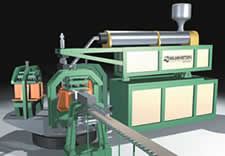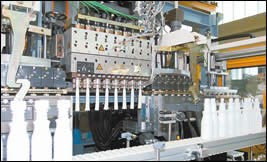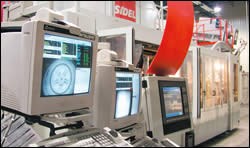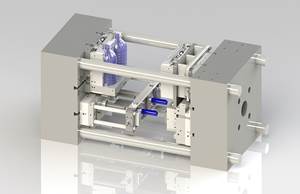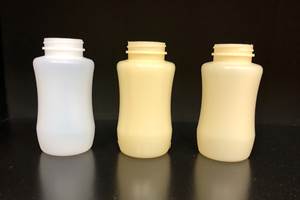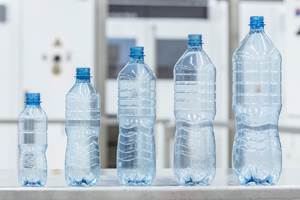NPE News Wrap-Up: Blow Molding
Long-stroke machines go rotary, all-electrics grow larger,and PET bottles get a new “glass” coating. Visitors to the show got to see all these and more.
Besides the blow molding machine launches we previewed before the show (see Blow Molding - Higher Output Vies With Flexibility and Blow Molding at NPE 2003), additional new developments surfaced on the show floor. These include a novel rotary long-stroke extrusion blow molder from Wilmington Machinery, a dual-station Hesta-Graham shuttle launched by GMG, and an all-electric machine introduced by Magic North America for bottles up to 8L. For PET bottles, NPE saw the emergence of new approaches to inspection and process control and the announcement of a new barrier-coating process.
News in extrusion blow
Wilmington Machinery says its new rotary long-stroke RLS-3 machine is a cost-competitive alternative to linear-shuttle long-stroke models (and, in some cases, to continuous wheel units) for high output of containers with calibrated necks. Jeff Newman, sales and marketing v.p., says the machine is highly flexible for making monolayer or coextruded parts ranging from personal-care bottles to jerry cans. It is also easily adapted to in-mold labeling.
The RLS-3 indexes molds on a rotary table between three (and potentially four) stations while using a single extrusion head. It works faster than the linear shuttle, thus raising output by about 50%, while keeping head-tooling costs the same. The unit also has a smaller footprint and permits tool changeovers in only 2 hr.
The RLS-3 has an extrusion capability of 2200 lb/hr, dry-cycle time as low as 3.5 sec, and 12 to 30 cavities. It uses a single-point bottle discharge system outside the machine to control flash and minimize waste generation.
In the vertical wheel category, Wilmington introduced an SB (Small Bottle) version to compete with reciprocating-screw machines for containers of less than 500 cc in monolayer and up to six-layer production. The target market is typically spin-trim dome containers like juice, dairy, and food bottles. The SB is offered in 18, 24, and 30 cavities, with throughputs up to 360 bottles/hr.
Meanwhile, Graham Machinery Group (GMG) has expanded its role in reciprocating-screw (RS) extrusion blow molding by acquiring a technology for making small, Uniloy-style RS units from Allied Plastics Systems (APS) in Tecumseh, Mich. The acquired technology is being upgraded for HDPE milk and water jugs and the first unit will be delivered to Keystone Containers in Reading, Pa. Until now, GMG has offered larger Improved-brand RS machines for returnable 30L polycarbonate water bottles.
GMG has also begun making German-designed Hesta-Graham linear shuttle machines in the U.S. The new dual-station, eight-cavity model HLD 700 offers single- or double-sided bottle discharge, upgraded controls, and stepper motors and servo valves for improved precision in parison thickness control, mold closing, and neck calibration.
Uniloy Milacron and FGH Systems are jointly introducing into the U.S. the new BWF16D, two-sided horizontal-shuttle model made in Germany by Uniloy. The three-parison BW machine ran trigger-style 17-oz HDPE bottles at the show in 12-sec cycles, said to be 17% faster than existing shuttles. The machine accepts tooling designed for other brands (FGH will modify tools and supply auxiliary equipment). A new delivery system that sucks bottles from the trim station rearwards to an exit conveyor helps minimize footprint. Center-fed Mueller die heads are said to ensure excellent wall thickness control and quick color changes.
Magic North America has expanded its EP family of all-electric shuttle machines to include one-sided (ND) and dual-sided (D) versions of a larger model, the L5-8 unit, for 8L bottles. Magic’s all-electrics now span the bottle range from 100 cc to 8L.
“Early emphasis in all-electrics was on their potential for up to 50% energy savings, but now cleanliness, accuracy, and low maintenance costs are drivers too,” states Joseph Bernard, Magic’s v.p. of technical marketing. Users of all-electrics include clean-room molders of pharmaceutical and cosmetic bottles and processors of hotel amenity bottles, who are shifting from stretch-blowing of PET to all-electric extrusion blowing of PETG. Magic plans to broaden its all-electric line over the next year to include a unit for up to 15L bottles and a reheat stretch-blow model for PET.
The China Syndrome
North American and European suppliers of blow molding equipment are expanding into the Pacific Rim to tap China as a low-cost manufacturing base and to satisfy that region’s growing appetite for sophisticated blow molding machines. GMG, for example, has forged alliances with Taiwan-based Fu Chun Shin Machinery Manufacture Co. (FCS) and Singapore-based Chee Eng Hang Ltd. (CEH). One deal lets CEH build Graham indexing rotary and linear-shuttle extrusion blow molders for Asian beverage, juice, and motor-oil bottle markets. Meanwhile, FCS will make Graham accumulator-head equipment in China. In return, GMG will distribute FCS injection molding presses in North America. The latter include hydraulic and hybrid-electric presses of 60 to 3000 tons. GMG will target industrial markets such as automotive part suppliers, many of which are already served by GMG’s industrial blow molding group.
Another industrial technique, 3D blow molding, has had a slow start in the U.S. despite being widely adopted in Europe for automotive fuel-system and under-hood parts. SIG Kautex, which demonstrated 3D suction blow molding at NPE, is seeking to give the method a push in this market. SIG Kautex has allied with Roush Industries, a product-development, tool-design, and prototyping specialist, to build and operate a 3D applications center at Roush’s plant in Livonia, Mich.
Lots of action in PET
At NPE, Sidel president Gerard Stricher said current high-output stretch-blow molding equipment has nearly exhausted the opportunities for raising output and lightweighting PET bottles. His point is underscored by Sidel’s demonstration at NPE of the new 24-cavity, two-station SBO-24 unit running 0.5L containers at a breathtaking 65,000 bottles/hr.
With the PET bottle industry still digesting this and other recent advances in efficiency, Stricher says the R&D emphasis has shifted to reducing machine downtime and bottle rejects. Sidel estimates that just 1 hr a week of downtime in a 24/7 stretch-blow operation costs up to $20,000 worth of lost production.
At the show, Sidel, a leader in stretch-blow molding equipment, announced an agreement with Pressco Technology aimed at enhancing quality inspection and process control of PET bottles. Pressco Intellispec machine-vision and process-control systems will be installed on all new Sidel high-output stretch-blow molders. Pressco mounts cameras on blow molders to inspect preforms and containers in real time as they are produced. Equally important is the decision by Sidel and Pressco to launch a joint R&D effort on machine vision and intelligent sensing. The partners plan to expand the real-time inspection concept to include closed-loop feedback for self-correction by the machine.
On the theme of PET bottle quality, David Dineff, marketing manager at Agr-TopWave, says that one critical need is to monitor PET material distribution in the bottle and its barrier integrity. His firm’s new system, PetWallplus with Vision, combines non-contact infrared measurement of bottle wall thickness with cameras for detecting visual defects. It operates at 40,000 bottles/hr.
Agr-TopWave also introduced a total QC system for PET preforms that can detect leaks, flaws in seals, and optical defects in sidewalls and bases. The Preformer handles 22,000 preforms/hr.
By late 2003, Germany’s SIG Corpoplast and Schott Hicotec expect to commercialize a new barrier coating for PET beer and juice bottles. A chemical plasma deposition process coats bottle interiors with a thin layer of glass (silicon dioxide), imparting oxygen and CO2 barrier while retaining high clarity. SIG expects the process to cost just $15 per 1000 bottles, 20% more than untreated PET. The company’s new rotary, 24-cavity Plastmax 12D coating machine can treat bottles at 10,000/hr.
Related Content
NPE2024 Wrap-Up: Sustainability Dominates Show Floor News
Across all process types, sustainability was a big theme at NPE2024. But there was plenty to see in automation and artificial intelligence as well.
Read MoreAt NPE, Cypet to Show Latest Achievements in Large PET Containers
Maker of one-stage ISBM machines will show off new sizes and styles of handled and stackable PET containers, including novel interlocking products.
Read MoreHow to Extrusion Blow Mold PHA/PLA Blends
You need to pay attention to the inherent characteristics of biopolymers PHA/PLA materials when setting process parameters to realize better and more consistent outcomes.
Read MoreFirst Water Bottles With Ultrathin Glass Coating
Long used for sensitive juices and carbonated soft drinks, KHS Freshsafe PET Plasmax vapor-deposited glass coating is now providing freshness and flavor protection for PET mineral water bottles.
Read MoreRead Next
Making the Circular Economy a Reality
Driven by brand owner demands and new worldwide legislation, the entire supply chain is working toward the shift to circularity, with some evidence the circular economy has already begun.
Read MorePeople 4.0 – How to Get Buy-In from Your Staff for Industry 4.0 Systems
Implementing a production monitoring system as the foundation of a ‘smart factory’ is about integrating people with new technology as much as it is about integrating machines and computers. Here are tips from a company that has gone through the process.
Read MoreFor PLASTICS' CEO Seaholm, NPE to Shine Light on Sustainability Successes
With advocacy, communication and sustainability as three main pillars, Seaholm leads a trade association to NPE that ‘is more active today than we have ever been.’
Read More



